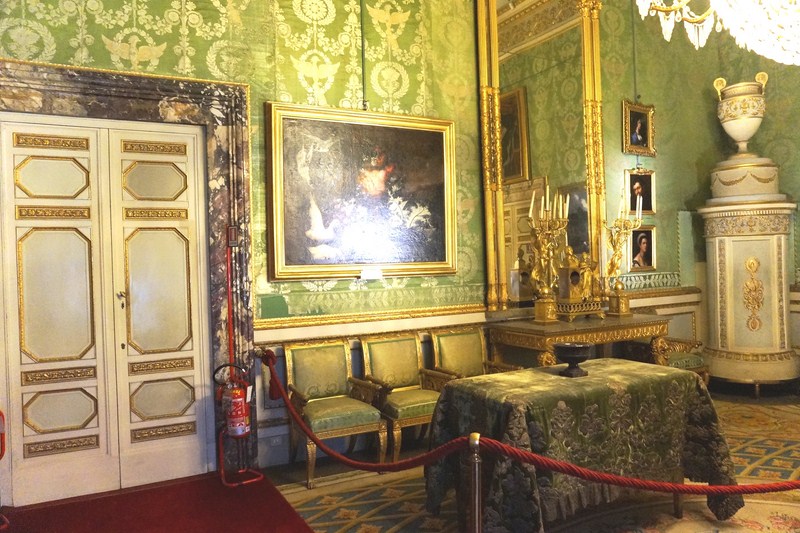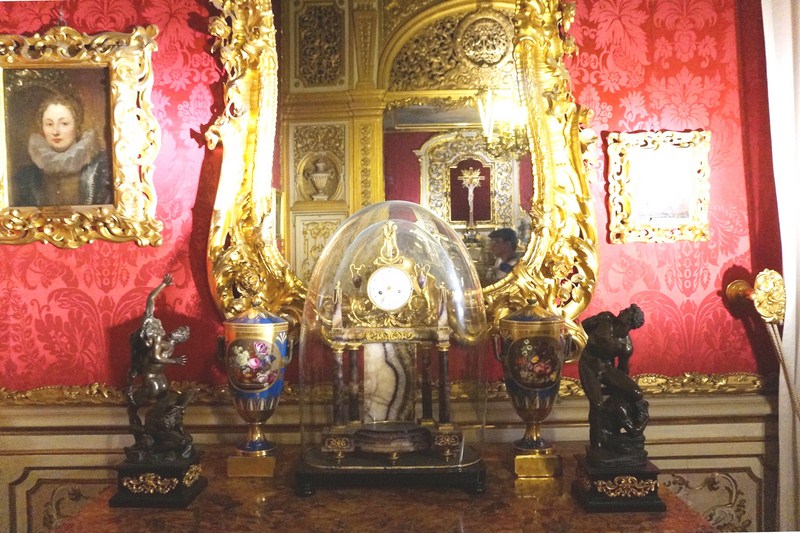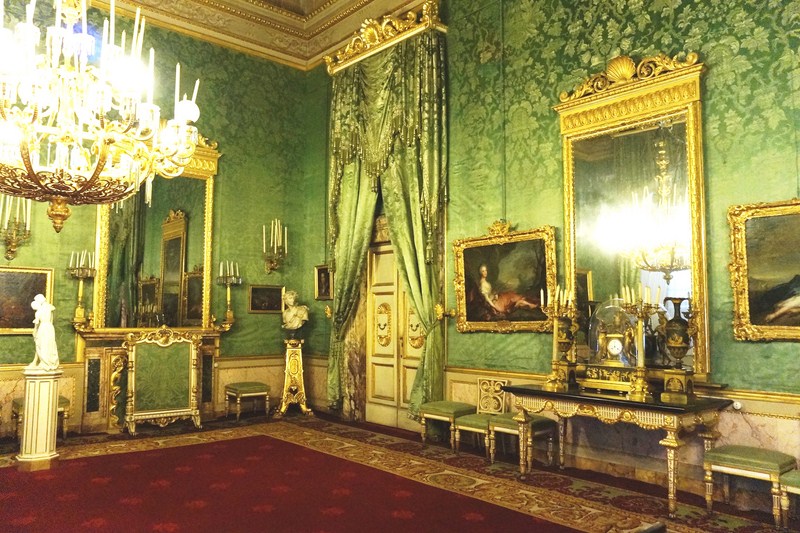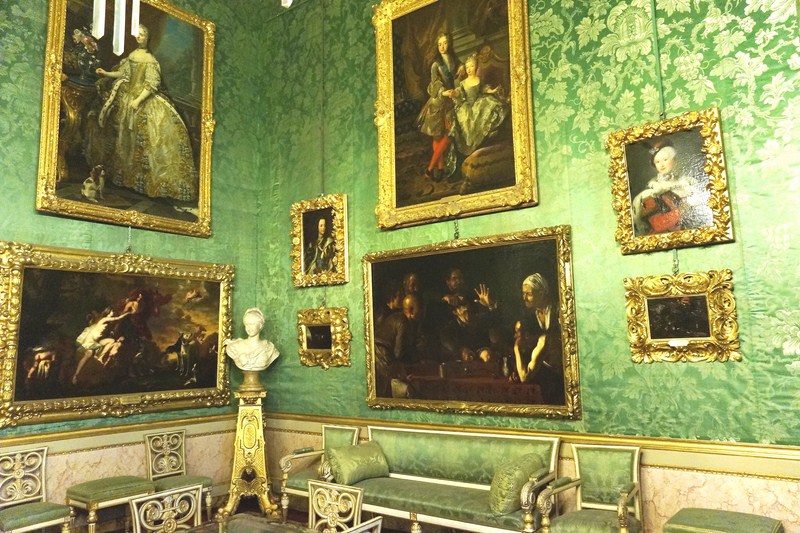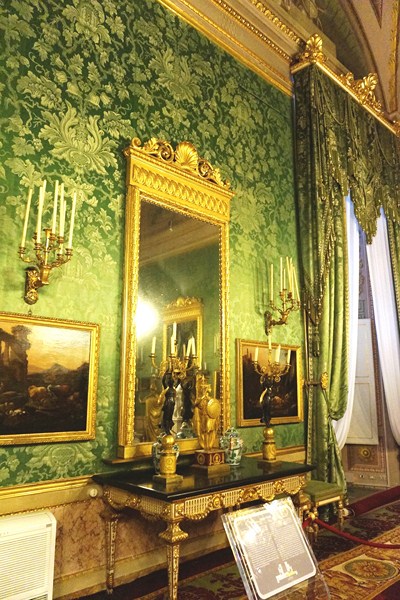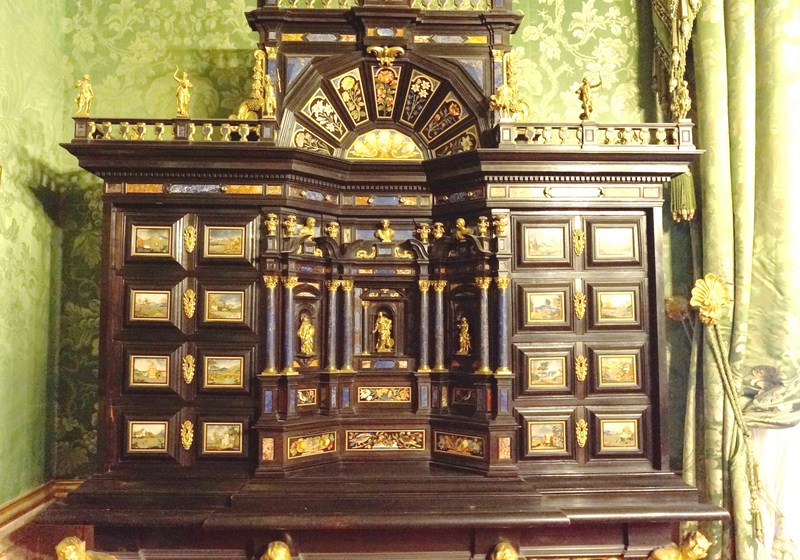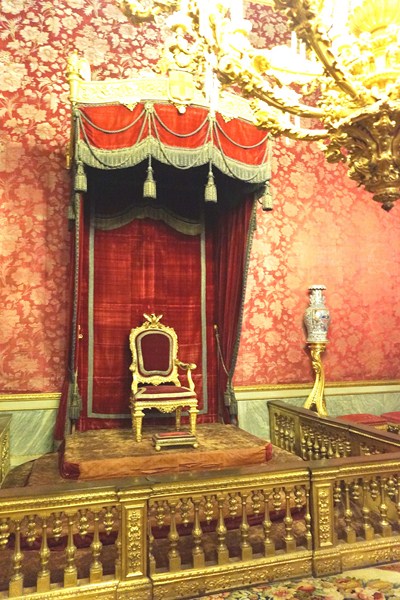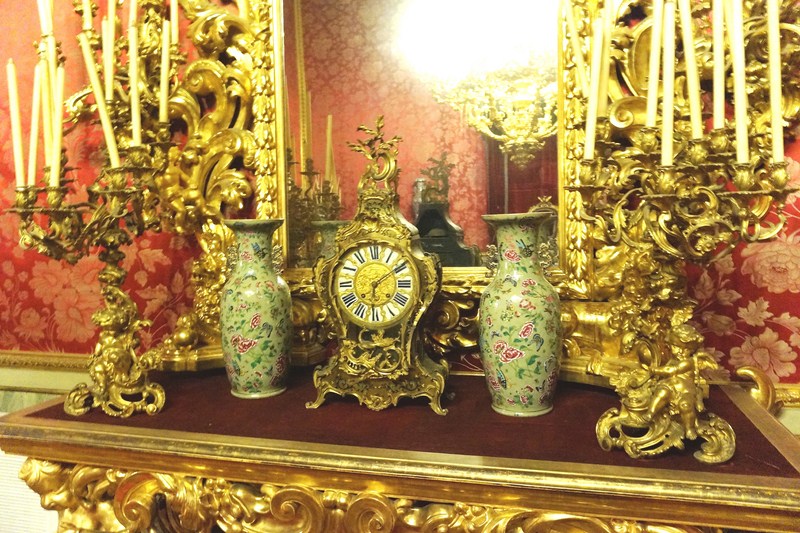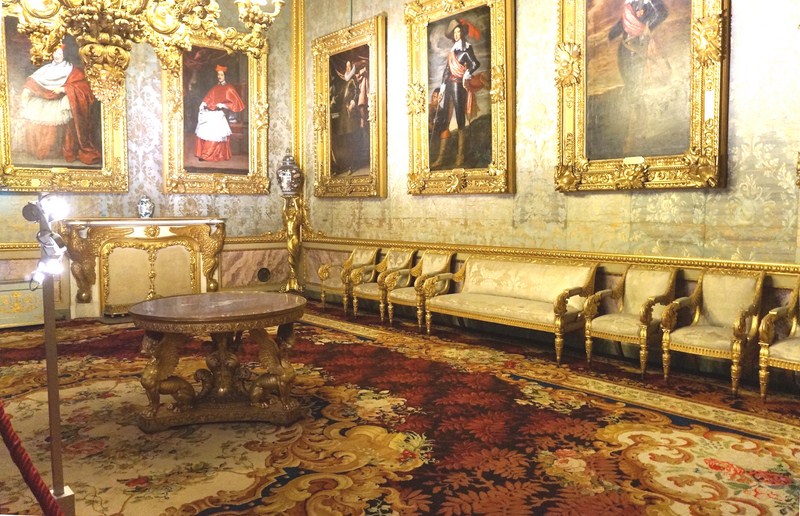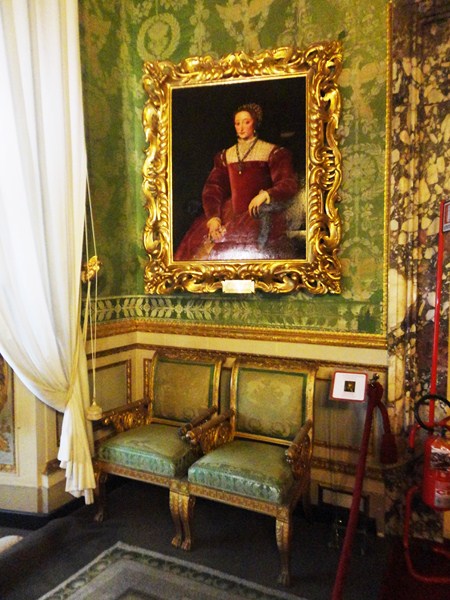From the Palatine Gallery, our visit continued to the monumental Imperial and Royal Apartments. Taking up 14 magnificent ceremonial rooms (now differentiated from the Palatine Gallery) at the right wing of the main floor of the Palazzo Pitti, it opened out along the south side of the Palazzo Pitti façade. Over three subsequent historical periods, they have been an important record of the history of the palace. The three different styles, corresponding to three different historical periods, are harmoniously balanced in that gives us an idea of its appearance before its transfer to the State in 1914.
Though their decoration has been changed to Empire style by the House of Savoy, there are still some rooms that maintain decorations and furniture from the age of the Medici. In 1911, restoration and general reorganization of the inventory of the paintings and furniture of the Pitti Palace was performed. After the recent refurbishing of the Apartments, started in 1987, these precious rooms were reopened to the public in 1993.
In contrast to the great salons of the Palatine Gallery, some of these rooms, while still grand and gilded, are much smaller, more intimate and are more suited to day-to-day living requirements with period furnishings including four-poster beds and other necessary furnishings not found elsewhere in the palazzo. From the 17th century onwards, these majestic rooms were the residence of the Grand Ducal Medici family (until their extinction in 1734), then of the Lorraine (Lorenese) family and, finally, of the Savoys (when, from 1866-1870, Florence became the second capital of unified Italy and Vittoria Emanuele II chose to make the Pitti the royal residence).
Bearing traces of the changing dynasties, these rooms were sumptuously furnished with pieces from the collections of the Medici, Habsburg-Lorraine and House of Savoy such as tables with semi-precious stone inlays, consoles and mirrors, furnishings and silk tapestries on the walls. These striking mixture of styles reflect the daily life and taste of the different periods and inhabitants.
The apartments still retain the layout given by the Grand Prince Ferdinando dei Medici, the son of Cosimo III. The few treasures from the Medici period that remain include the precious 17th century ebony and semi-precious stone cabinet that belonged to the Grand Duchess Vittoria della Rovere (the wife of Ferdinando II) and the chapel. The prevailing appearance of the Royal Apartments, as seen today, is that given them, in the fourth and fifth decades of the 19th century, by the Neo-Classical taste of the Lorraine-Hapsburgs. These rooms were given its final character by the Savoys who left a strongly eclectic and distinctive stamp of their taste on the general appearance of the Royal and Imperial Apartments, which is still visible today.
The Grand Dukes of the House of Habsburg-Lorraine altered, restored and re-furnished the apartments, between the end of the 18th century and the first half of the 19th century, according to the changing taste of the period, decorating the ceilings with stucco and Neo-Classical subjects and the Oval Room (known as the Queen’s Dressing Room) with light hand-embroidered silk panels to the designs of Ignacio Pellegrini, and the ceiling with colored Rococo stucco.
From 1865, during the time of the sovereigns of the House of Savoy, some rooms (notably the chapel) were also entirely refurnished and carpeted, between the end of the 18th and the beginning of the 19th centuries, according to the Empire style of the period.
The Green Room (Salone Verde), frescoed by Giuseppe Castagnoli in early 19th century, exhibits an Intarsia Cabinet from the 17th century and a collection of gilded bronzes. The name of the room comes from the green color of the wall coverings, curtains and the upholstery on some of the furniture (which are all in silk – textured or plain) fitted, between 1854 and 1855, by Florentine manufacturers.
In that period, the room was completely redecorated, like the Blue Room and the Throne Room that follow it, earning the name of Fabric District (Quartiere delle Stoffe). Since the last Grand Duke, Leopold II of Lorraine had chosen the new Palazzina della Meridiana as his home, it was used first as a reception room.
Also from the same period are the carpet (made by the prestigious Royal Works of Tournai, in northern France, and decorated with late imperial motifs), a pair of lamps, the brackets for the candle holders, the fire guard and the fireplace mirror (carved in imitation of the two placed above the slightly older consoles). Coming from different periods are the rest of the furnishings and paintings (starting with the canvas on the ceiling, the Allegory of Peace between Florence and Siena, painted by Luca Giordano in 1682 for Cosimo III.
The Stipo cabinet, belonging to Vittoria della Rovere, is definitely the most important piece of furniture. This monumental work of art, from the ducal workshops of the 17th century, emulated, on a small scale, the Historicist style of the side table from the Opificio delle Pietre Dure (delivered to the Pitti Palace in 1852 and subsequently placed in the room), with the Savoy period typical nonchalant style and tone.
The Throne Room (Sala del Trono), decorated for King Vittoria Emanuele II of Savoy, was used for official audiences as well as to hang some of the paintings from his famous collection. The throne is under a canopy. The royal setting is emphasized by the large mirrors on the walls (to multiply the images of the king) as well as by the sumptuous mid 19th century Baroque red damask silk lampas ensemble on the walls.
The throne area was set out later, for the arrival of the Savoy monarch, and then, after 1871, changed again when the balustrade and audience chair were added with the emblem of the Savoys. On the ceiling arch are the triumphant decorations by Giuseppe Castagnoli (1754-1832) while the image of Jupiter enthroned is framed with monochrome decorations.
The room has been further enhanced by a richly inlaid, gilded lamp while inlaid and gilded console tables are decorated with candelabras and imposing 17th-18th century Oriental Japanese and Chinese porcelain vases.
Like the Green Room and the Throne Room, the Blue Room (Salotto Celeste) was also renewed between 1854 and 1855 when this suite was known as the new Fabric District (Quartiere delle Stoffe). The room stands out for the Neo-Baroque decorative style, updated to the fashions of Paris and London in the mid-19th century. After the addition of new wallpaper (in this case, a shade of blue), the room was also given a carpet made by French weavers in Tournai. Furnishings include a small round table, with a pietre dure top on a base in porphyry, and the four candle holders.
The Blue Room pays homage to some members of the Medici family or those who were joined to it by marriage (except Cardinal Camillo Francesco Maria Pamphili) who, during the course of their lives, had spent time in these spaces. Hung on the walls are 10 of a series of 12 portraits painted between 1621 and 1645 by court painter Giusto Sustermans (1597–1681), all identical in size and given new frames in the 1720s on the wishes of Grand Duke Cosimo III. They include a full-length portrait of Christina of Lorraine, her daughter Claudia and husband Leopold of Austria, Cosimo II’s children, Francesco and Mattias, painted a few years later, Grand Duke Ferdinand II and Cardinal Carlo de’ Medici.
The large chandelier, the oldest (dating back to the 17th century) still in the palace, was carved by Vittorio Crosten. The white stucco and gold ceiling dates back to the period of Peter Leopold of Lorraine. The “eagle” fireplace was done by Francis Harwood, an Englishman (who moved to Florence, where he ended his days in 1783) who worked as a portrait painter and copyist of Roman antiquities for travelers on the Grand Tour. He was employed by the Grand Duke to restore the sculptures in the palace and the Boboli Gardens.
The Parrot Room (Sala dei Pappagalli), named for the bird (actually imperial eagles) motif in the beautiful silk lampas wall coverings (which have a green background and were made in the manufactory of Lyon in France and brought by Grand Duke Ferdinando III from Vienna in 1814), divides the King’s Apartment (extending along the internal courtyard) from the Queen’s Apartment, which follows the southern axis. The Lorraine family installed the large stove. The carpet and crystal chandelier both date from the 19th century.
In these public and private rooms, the Savoyard Period’s (1860-1919) eclectic taste (as described in the 1911 inventory) is particularly evident. The clock, with its chased and gilded bronze shelf and black marble base, was made in 1812 by Pierre Philippe Thomire, a famous Parisian bronze maker.
The “recycling” of works of art, typical of the Restoration (c. 1815), includes the original bust of Napoleon being replaced with the bust of Ferdinando III and the imperial eagle with the allegorical figure of Tuscany. The table cover, of silk and gilded silver, is in Louis XV style. Impruneta Fair, by Filippo Napoletano, is a depiction of the famous fair held near Florence every October 18th.
The Chapel, intended by Grand Prince Ferdinando de’Medici (who lived there until his death in 1713) to be an alcove, or rather, an official bedroom (the real bedroom for sleeping was two doors further on) designed to receive a small group of people, shows the most obvious traces of the Medici story in the palace.
However, the echoes of the Medici style were cushioned during the Savoy rule when, with the aim of providing a seamless sequence of representation rooms, the furnishings were updated, including the table, mirror, vases and clock, and the accents that were probably considered too severe.
In the bed compartment, there is still a door that leads, by way of a spiral staircase, into a small library, closed by panels and cornices in different types of wood, decorated with plant motifs by French inlayer Riccardo Lebrun.
Mainly Late Baroque in style, the area is enhanced by a crimson silk damask ensemble which, although dating back to the mid 19th century, picks up on the designs and motifs in use in the previous century, establishing a seamless dialog with its, late 17th century character still evident in the articulate white stucco and gold decoration and in the gilded inlaid work by Giovan Battista Foggini (1652-1725), carried out between 1685 and 1687, with scrolls and mottoes referring to Ferdinando and his wife, Violante of Baviera. With the arrival of the Grand Dukes of Lorraine, the alcove was converted to a chapel.
Today, this area contains a mix of holy paintings and other highly crafted pieces. The Virgin and Child, painted in 1675 by Carlo Dolci (1616-1686) for Vittoria della Rovere (widow of Ferdinando II de’ Medici), has a sumptuous and precious pietre dure frame, probably created from designs by Foggini on the occasion of the wedding of Prince Gian Gastone in 1697.
Other holy paintings shown here include two round works from the school of Sandro Botticelli and a 17th-century copy of Leonardo da Vinci’s Virgin on the Rocks (noted, above all, for its Baroque frame).
Royal Apartments: First Floor, South Wing, Pitti Palace, Piazza de’ Pitti, 1, Florence, Italy. Tel:+39 055 294883. Open Tuesdays-Sundays, 8:15 AM – 6:50 PM. Admission: Palatine Gallery (€8.50), Silver Museum (€6.00), Gallery of Modern Art (€8.50), Costume Gallery/Porcelain Museum/Boboli Gardens/Bardini Garden (€6.00).
How to Get There: Take the C3 or D bus to the Pitti stop.


